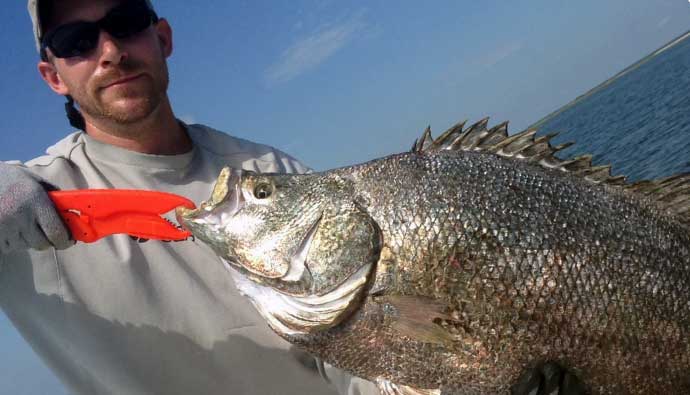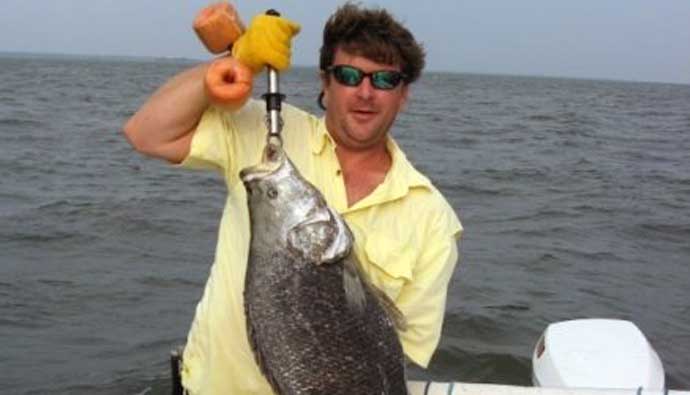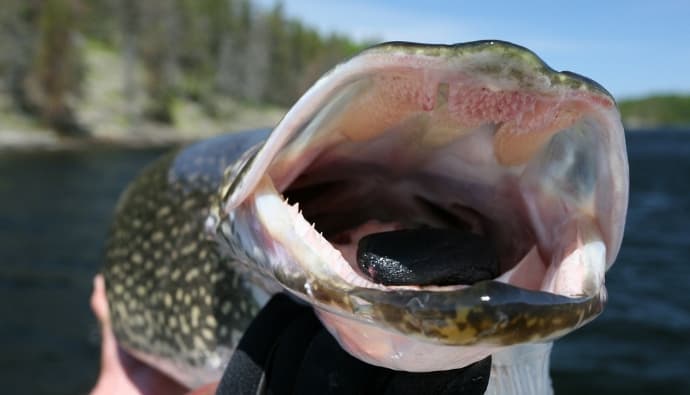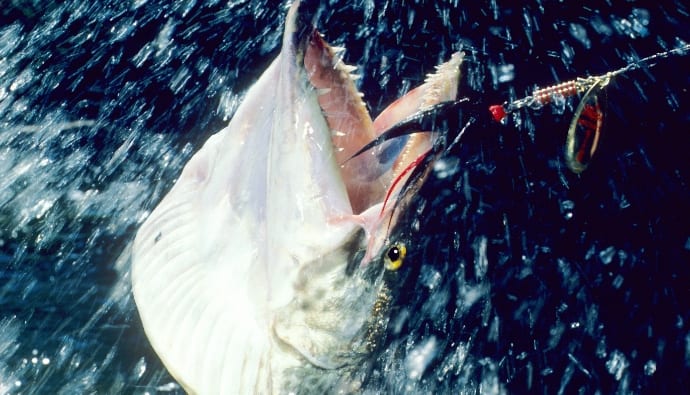If there’s one thing for certain, the tripletail fish has a unique-looking set of fins.

This guide will explain why we think it’s special and how you can catch more of them.
Listen to more fishing tips on the Cast & Spear Podcast
Overview
Also known as blackfish, black grunt, buoy fish, conchy leaf, and black perch, this fish belongs to the Lobotidae family and is prized by anglers.
Tripletail Facts
The tripletail is flat and shaped like an overly large almond. It has round caudal, dorsal, and anal fins which look like 3 tails (thus the name ‘tripletail’), and a triangular head that changes in shape as it ages. The unique fins allow the species to swim/float sideways, imitating a leaf, an effective camouflage that fools predators.
However, even though they swim like flounders, the triple tail remains near the surface of the water, imitating leaves and flotsam. The fish can also change its color according to its habitat making its disguise complete. That’s why you can find several tripletail fish pictures online that look distinct from one another.
Tripletail can be found along the gulf coast and in tropical and temperate waters across the globe, such as Japan, Fiji, and Tuvalu. However, it is not related to any grouper species that is found on the gulf coast.
| Scientific Name | Lobotes surinamensis |
| Common Name(s) | Atlantic Tripletail |
| Family | Lobotidae |
| Identifying Characteristics | Three almond-shaped fins (caudal, dorsal, and anal fins) and a triangular head. |
| Habitat | It can be found along the gulf coast and in tropical waters in Japan, Fiji, and Tuvalu. |
Habitat & Feeding
The tripletail is usually solitary but can be found in schools as well. Look for it in bays, estuaries, and sounds in the summer, and fry remains under algae in Florida. Adults can be found in passes, inlets, and bays that are near the mouth of rivers. You can also find fish around shipwrecks, jetty pilings, and buoys.
This species is the only one in the family of Lobotidae that can be found in the Atlantic Ocean.
The tripletail is an opportunistic eater i.e. they just float sideways in the water to fool prey into coming near before striking. This includes shrimp, blue crabs, anchovies, and gulf menhaden.
How to Catch Tripletail Fish

The tripletail may look and act strange, but it is an excellent table fish, one of the main reasons why it is prized by fishermen. A tricky one to catch, here are some tips that can help you increase your chances of a good haul.
Best Rigs
If you are targeting a large tripletail fish, go with a rod that is stiff and can set the hook without trouble and hold plenty of lines. If you are using bait, make sure you have a short leader and a popping cork.
Best Spots
The process of fishing for tripletail is sight fishing. Search for tripletail in Florida by keeping your eyes peeled for anything that is floating (yes, floating objects) on the surface of the water, and chances are you will spot one floating near it as well. This includes weed lines, floating coconuts, wooden pallets, branches, and crab/lobster trap buoys. It will look like a large garbage bag and will not dive too deep.

Best Times
The triple tails fish can be found in Florida waters during spring, summer, and fall. It spends a lot of time close to shore between March and November in inlets, bays, estuaries, and lagoons. During the winter, it moves offshore or south to escape the cold weather. However, the tripletail can be found year-round in the south of Florida.
The crabbing season in the Gulf Coast starts in October, which means you can find thousands of traps/hangouts for tripletails during the season. A lot of them will be floating close together during this time so that you won’t have any trouble catching them.
Fishing Tips
Here are a few more tips to help you catch tripletail fish!
- Tripletail can grow as large as 40 pounds in Florida, so you need a heavy tackle and hefty gear to catch the fish. Plus, it has sharp gill plates that can make short work of a thin line, and a caught one will put up a fight that can also break it. Prevent injuries and the fish from escaping by using a spinning tackle that can withstand a 15 to 20-pound test and a heavy leader that can protect you from those lethal gill plates. The rod should be strong and capable of fast action so that you can set the hook before the fish has a chance to spit it out.
- If you prefer to use live bait to catch tripletail, use shrimp, small fiddler crabs, and small baitfish. If you prefer artificial bait, fake shrimp soft baits will work. These are scented and flavored and will prove irresistible to the opportunistic fish.
- Tripletail has small mouths, so use J style hooks that are 1/0 or 2/0 in size. If you encounter windy conditions, use a lightly weighted jig that can float under the surface of the water without sinking.
- Count to 3 or 4 before setting the hook when the caught tripletail goes for the bait so it can set in firmly. The fish has a really hard mouth, so this is necessary.
How to Cook Tripletail
- Preheat the oven to 325F.
- Butter a baking dish that is large enough to fit the fish.
- Season the tripletail fillets with 1 teaspoon of salt, 1 teaspoon of black pepper, 2 teaspoons each of garlic, and onion powder.
- Place the seasoned tripletail fillets in the baking dish and smear 2 tablespoons of softened butter on top.
- Pour half a cup of key lime juice, 1/4 cup of orange juice, and half a cup of lime juice on the fish and add 3 slices of lime and 2 orange slices on top.
- Pop the dish in the preheated oven and cook till the fish is flaky and opaque (20 to 25 minutes).
Frequently Asked Questions
Live tripletail in Australia can grow to weigh as much as 22 pounds and can grow to 40 inches in length. But most don’t weigh more than 6 to 7 pounds.
The meat of tripletail is sweet, firm, and flaky which is why it is coveted by anglers.
You won’t catch any tripletail if you don’t have a rod that can take the fight the species will put up once it is hooked.
Read Also: How to Catch Tautog Fish




 Facebook
Facebook YouTube
YouTube








